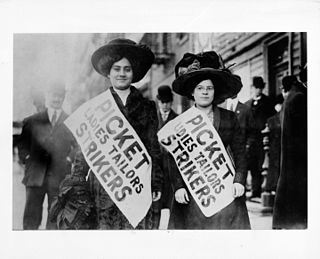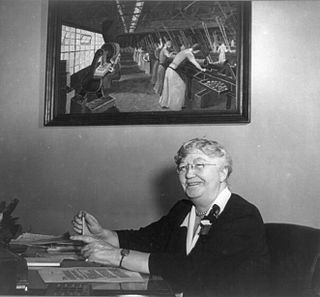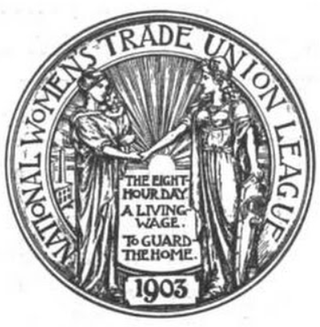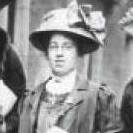A trade union or labor union, often simply referred to as a union, is an organization of workers whose purpose is to maintain or improve the conditions of their employment, such as attaining better wages and benefits, improving working conditions, improving safety standards, establishing complaint procedures, developing rules governing status of employees and protecting and increasing the bargaining power of workers.
Labour laws, labour code or employment laws are those that mediate the relationship between workers, employing entities, trade unions, and the government. Collective labour law relates to the tripartite relationship between employee, employer, and union.

The Women's Trade Union League (WTUL) (1903–1950) was a U.S. organization of both working class and more well-off women to support the efforts of women to organize labor unions and to eliminate sweatshop conditions. The WTUL played an important role in supporting the massive strikes in the first two decades of the twentieth century that established the International Ladies' Garment Workers' Union and Amalgamated Clothing Workers of America and in campaigning for women's suffrage among men and women workers.

Agnes Nestor was an American labor leader, politician, and social reformer. She is best remembered for her membership and leadership roles in the International Glove Workers Union (IGWU) and the Women's Trade Union League (WTUL), where she organized for women's suffrage and workers' rights. Nestor's prominent activities included organizing women workers in Chicago in the early 1900s, running for public office, serving on national commissions to promote education, and securing work-hour limitations for women.

Ex parte H.V. McKay, commonly referred to as the Harvester case, is a landmark Australian labour law decision of the Commonwealth Court of Conciliation and Arbitration. The case arose under the Excise Tariff Act 1906 which imposed an excise duty on goods manufactured in Australia, £6 in the case of a stripper harvester, however if a manufacturer paid "fair and reasonable" wages to its employees, it was excused from paying the excise duty. The Court therefore had to consider what was a "fair and reasonable" wage for the purpose of the act.

The New York shirtwaist strike of 1909, also known as the Uprising of the 20,000, was a labour strike primarily involving Jewish women working in New York shirtwaist factories. It was the largest strike by female American workers up to that date. Led by Clara Lemlich and the International Ladies' Garment Workers' Union, and supported by the National Women's Trade Union League of America (NWTUL), the strike began in November 1909.

Indian labour law refers to law regulating labour in India. Traditionally, the Indian government at the federal and state levels has sought to ensure a high degree of protection for workers, but in practice, this differs due to the form of government and because labour is a subject in the concurrent list of the Indian Constitution. The Minimum Wages Act 1948 requires companies to pay the minimum wage set by the government alongside limiting working weeks to 40 hours. Overtime is strongly discouraged with the premium on overtime being 100% of the total wage. The Payment of Wages Act 1936 mandates the payment of wages on time on the last working day of every month via bank transfer or postal service. The Factories Act 1948 and the Shops and Establishment Act 1960 mandate 15 working days of fully paid vacation leave and 7 casual leaves each year to each employee, with an additional 7 fully paid sick days. The Maternity Benefit (Amendment) Act, 2017 gives female employees of every company the right to take 6 months' worth of fully paid maternity leave. It also provides for 6 weeks worth of paid leaves in case of miscarriage or medical termination of pregnancy. The Employees' Provident Fund Organisation and the Employees' State Insurance, governed by statutory acts provide workers with necessary social security for retirement benefits and medical and unemployment benefits respectively. Workers entitled to be covered under the Employees' State Insurance are also entitled to 90 days worth of paid medical leaves. A contract of employment can always provide for more rights than the statutory minimum set rights. The Indian parliament passed four labour codes in the 2019 and 2020 sessions. These four codes will consolidate 44 existing labour laws. They are: The Industrial Relations Code 2020, The Code on Social Security 2020, The Occupational Safety, Health and Working Conditions Code, 2020 and The Code on Wages 2019.

Mary Anderson was a Swedish-born American labor activist and an advocate for women in the workplace. A feminist, she rallied support to ratify many new laws to support women and equal rights. Throughout her lifetime, Anderson held a large range of roles, rising from a factory worker to the Director of the Women's Bureau in the United States Department of Labor. Anderson's work to protect the rights of women in the workplace made no small impact on the lives of working women across the country.

Mary Reid Anderson was a Scottish suffragist and was a leading trades unionist. She was the general secretary of the Women's Trade Union League and was involved in the formation of the National Federation of Women Workers and National Anti-Sweating League.

Munitionettes were British women employed in munitions factories during the time of the First World War.
The Women's Trade Union League, founded in 1874 and known until 1890 as the Women's Protective and Provident League, was a British organisation promoting trade union for women workers. It was established by Emma Paterson, who had seen unions managed by working women in America.

The Cradley Heath Workers' Institute was built between 1911 and 1912 in Lomey Town, Cradley Heath, West Midlands, England. It was built as a social centre for the people of Cradley Heath and surrounding areas within the Black Country, intended to become a venue for educational meetings and lectures. It also housed Union offices, where members could come to seek guidance, and from which the Contributory Unemployment Fund would be distributed. In 2006 the building was threatened by a bypass and so was moved to the Black Country Living Museum in a collaborative project including Sandwell MBC, Midlands TUC and funded by the community and the Heritage Lottery Fund.

Julia Varley, OBE was an English trade unionist and suffragette.
The First International Congress of Working Women (ICWW), convened by the Women's Trade Union League of America from October 28 to November 6, 1919, was a meeting of labor feminists from around the world. The ICWW planned to share their proposals for addressing women's labor concerns at the First International Labor Conference (ILC) of 1919. ICWW delegates agreed upon a list of resolutions, some of which were taken up by the ILC's Commission on the Employment of Women and resulted in the passage of the Maternity Protection Convention, 1919.

Women in labor unions have participated in labor organizing and activity throughout United States history. These workers have organized to address issues within the workplace, such as promoting gender equality, better working conditions, and higher wages. Women have participated in unions including the Collar Laundry Union, the WTUL, the IWW, the ILGWU, and the UAW.

Catherine McLean known as Kate McLean and later Kate Beaton was a British trade unionist and councillor in Glasgow. She led the National Federation of Women Workers (NFWW) and several disputes including the six-month-long networkers strike in Kilbirnie in 1913.
The Bangladesh Garment Workers Trade Union Centre (GWTUC) is a trade union federation of garment workers in Bangladesh. It is one of the largest trade unions in that sector, with more than 20 factory trade unions affiliated to it. It has enough members to be formally recognised as a trade union, but does not have that status, as is not uncommon for left-oriented unions in Bangladesh. Politically, GWTUC is aligned with the Communist Party of Bangladesh.
The 1973 Durban strikes which were part of the wider Durban Moment, were a series of labour disputes and worker-led demonstrations held in Durban in 1973. African workers across various sectors deliberately withheld their labour in an attempt to demand higher wages and better working conditions. Beginning on 9 January 1973, mass strikes broke out in Durban and continued for three months until the end of March. The strikes involved roughly 60 000 African workers and impacted more than 100 firms. The highest number of strikes occurred on the outskirts of Durban in textile, metal and chemical plants. Although the number of strikes declined after March, 100 000 African and Indian workers were reported to have taken some form of industrial action by the end of 1973.
The 1916 Hamilton machinists' strike was a labour dispute in Hamilton, Ontario, Canada involving between 1,500 and 2,000 workers employed in the manufacturing of munitions and other materials for World War I. It began on June 12 and involved those employed at all of the major manufacturers, including the National Steel Car Company, the Steel Company of Canada, Dominion Steel Foundry, Canadian Westinghouse Electric & Manufacturing Company, Fensom Elevators. Involving members of the International Association of Machinists, Amalgamated Society of Engineers, and unorganized workers, it ended in defeat for Hamilton's machinists.
Dorothy Mary Elliott was a leading British feminist and trade unionist. She was Chairman (sic) of the National Institute of Home Workers until 1959.
















